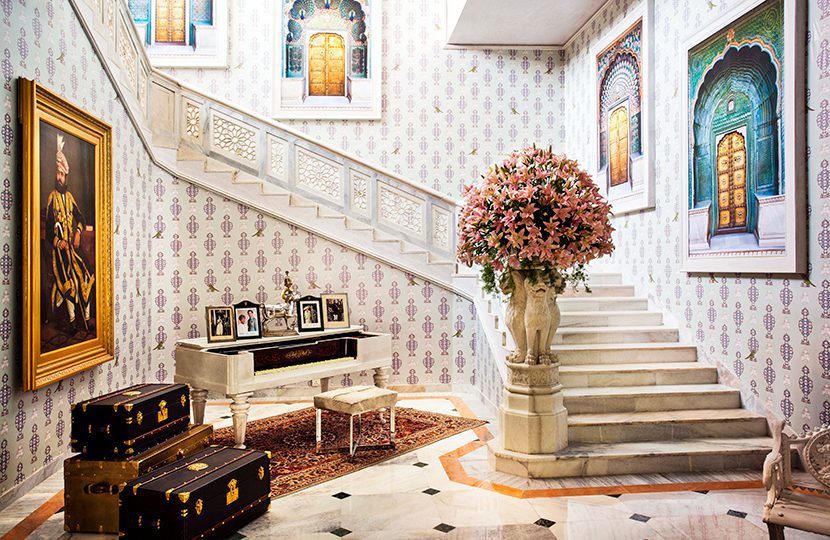[vc_row][vc_column][vc_column_text]In the midst of negotiating the hectic roads of Jaipur, the bustling capital of Rajasthan, our driver suddenly swings the car into a discreet driveway. We pass through a turreted “elephant gate” painted a pretty pale pink and follow the gravelled route flanked by verdant gardens before pulling up outside a palace painted in the same pink as the regal entranceway. Half a dozen smiling and smartly dressed men each wearing a distinctive candy pink turban wait to welcome us. We are greeted – rather fittingly for The Pink City – with a glass of rose sparkling wine.
We are greeted – rather fittingly – with a glass of rose sparkling wine
So far, so Jaipur perhaps but inside is a complete surprise. Sujan Rajmahal Palace, now a luxury boutique hotel, may be approaching 300 years old but its interior has been decorated in a refreshingly contemporary way. Each of the public spaces is adorned with fantastically striking, custom made wallpaper from bright pinks and turquoise blues to sultry Art Deco Chinoiserie and Indian inspired designs. The chandeliers, antiques and paintings remind you however that you are staying in a royal residence.
As palaces go Rajmahal is on the petite side rather than a mammoth mausoleum with just 14 guest rooms – it was commissioned by Maharaja Sawai Jai Singh II for his wife. Society interior designer Adil Ahmad, recently commissioned to spruce the place up, has achieved a sumptuous cosiness that feels like a private home albeit a very grand one. Jaipur’s royal family still own Rajmahal (it is run by Sujan, the renowned company behind three luxury tented camps in Rajasthan) and the princess has an office in the grounds though they reside in the far larger City Palace in old Jaipur (the hotel can arrange a private tour of this palace as well as secure you a set in the royal box at the polo).[/vc_column_text][/vc_column][/vc_row][vc_row][vc_column][vc_column_text]
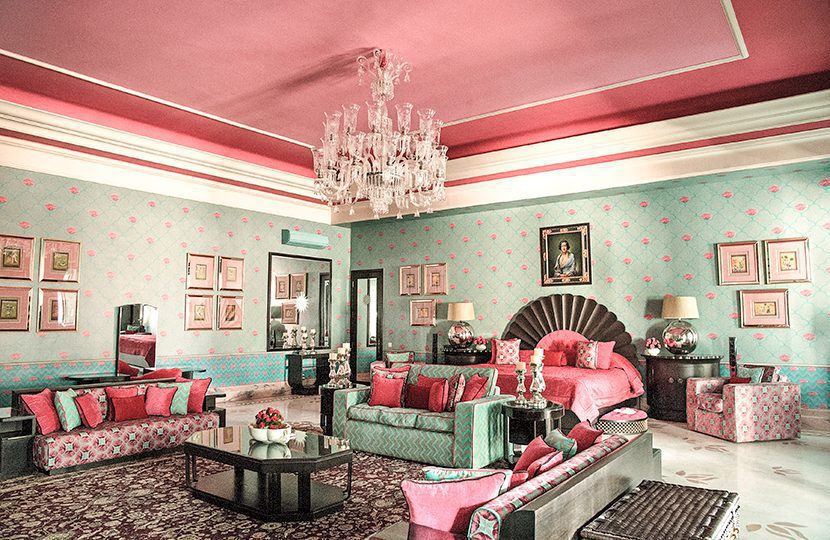
The Maharani Suite at the Rajmahal Palace
[/vc_column_text][/vc_column][/vc_row][vc_row][vc_column][vc_column_text]While still a royal residence, Rajmahal played host to the likes of Queen Elizabeth the second, the Prince and Princess of Wales and Jackie Kennedy as the framed black and white photographs and the names of the suites attest. Beautiful carpets gifted by another distinguished visitor, the Shah of Iran, hang on the walls as the Maharini magnanimously wanted everyone to enjoy them. The family’s love of “the sport of kings” is also reflected in The Polo Bar, lined with trophies and photographs.
Our Palace Room is reached via a stunning marble staircase and like all the guest rooms and suites lies discreetly behind mirrored doors which adds to the feeling of a private home. Inside our host tells me “A Maharini does not make her own coffee,” before explaining that there are no facilities for hot beverages in the room: “You ring, and we will bring you coffee.”
Once you’ve ticked off sightseeing inside the old walled city and the Amber Fort; and shopped ‘til you’ve dropped in the bazaars and boutiques, Rajmahal Palace provides a whimsical oasis. We spend our days exploring in the early mornings, after breakfasting on fresh juice and stuffed parathas, and retreating to Rajmahal in the heat of the afternoon. The hotel has the bonus of a large, glamorous looking swimming pool surrounded by inviting sun loungers. The designer has had fun here too with a shady terrace complete with mirrors and modern chandeliers which look spectacular at dusk. And a note for shopping fans: there’s a branch of the revered New Delhi based Kashmir Loom at Rajmahal so you can stock up on the best cashmere shawls without leaving the grounds.Another unique touch is that afternoon tea is served to hotel guests every day between 4 pm and 6 pm. You may have it wherever you wish, but one particularly charming spot is on the manicured lawn under a series of attractive open sided tents (pale pink of course).[/vc_column_text][/vc_column][/vc_row][vc_row][vc_column][vc_column_text]

Raghunathji Temple near Amanbagh
[/vc_column_text][/vc_column][/vc_row][vc_row][vc_column][vc_column_text]A pleasant surprise for the (relatively) diminutive size of the hotel is that there are three dining rooms, each more strikingly designed than the other: the grand Orient Occident is open for dinner while the cool mint Colonnade and 51 Shades of Pink (decorated as the name suggests) restaurants both serve breakfast and lunch. All offer the same menu of Indian and Western dishes; we stuck resolutely to the former which is excellent.
We also tried one of the Sujan Rajmahal Palace’s private dining experiences one evening, dining in one of the aforementioned tents on the lawn. At night the scene is enticingly lit by lanterns and makes for a gorgeous venue. As a Rajmahal guest, arrangements may also be made for a private dining experience at the City Palace.
In the golden light we pass camel and carts and goats being herded
Some 80 kilometres outside Jaipur deep in the countryside is a former royal hunting ground turned exclusive retreat. The tranquil
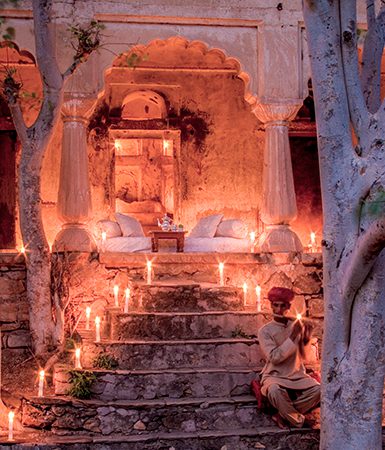
Private dining organised by Amanbagh
Amanbagh, part of the elite Aman resorts, surrounded by the Aravali Hills is the perfect antidote to energetic Jaipur.
As we draw nearer we pass through a village entirely devoted to the craft of stone masonry. Apparently, orders are placed for these statues from far and wide across the region. The landscape becomes rockier and the road bumpier until we reach the ancient walled grounds of Amanbagh. Within are palm, mango and fig trees and a camel trots down the driveway ahead of us. “He is Babu, our in-house camel,” explains our driver. Lucky old Babu being an Aman camel I can’t help but think.

A private dining experience in rural Rajasthan organised by Amanbagh
Although Amanbagh is 21st century built it’s classic fairytale India in its design: all romantic domes and archways, colonnades and courtyards, in pink marble and sandstone. Our room is a Pool Pavilion, a standalone villa with its own private swimming pool. We spend most of our time in the terraced garden and are joined variously by families of monkeys and colourful butterflies and birds that swoop over the pool.[/vc_column_text][/vc_column][/vc_row][vc_row][vc_column][vc_column_text]
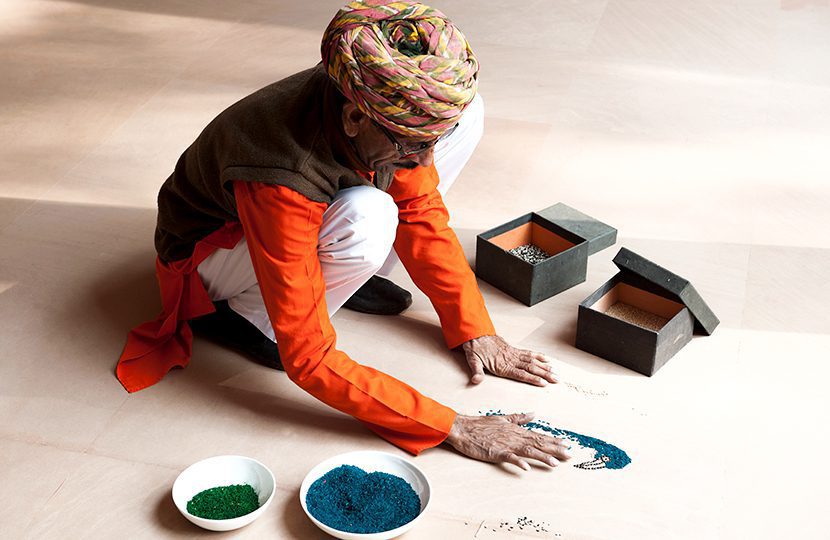
Amanbagh staff make a peacock art feature from coloured rice
[/vc_column_text][/vc_column][/vc_row][vc_row][vc_column][vc_column_text]Some guests come to Amanbagh for safari trips to the nearby Sariska Tiger Reserve (further afield Ranthambore may be more well-known, but Sariska is less crowded and has a high rate of tiger sightings); others book in for the four to 21-day Ayurvedic programmes. And there are easily do-able day trips to lesser visited sites such as the temples of Neelkanth, serene Somsagar Lake (good for picnics or meditation) and the abandoned city of Bhangarh where you are more likely to encounter monkeys and peacocks than other tourists. As such it makes for a special place for a yoga session. But one of the unique, unforgettable experiences of Amanbagh is simply to witness rural Rajasthani life around you.
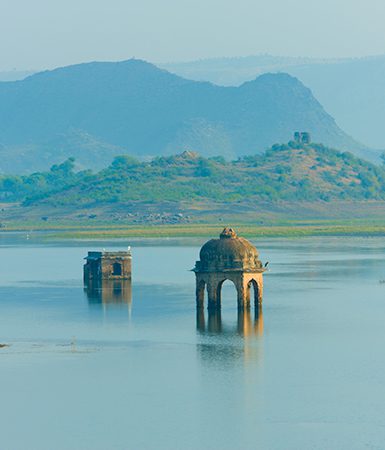
Beautiful Landscapes of a bygone era
One evening we joined aarti at the local roadside temple where devout locals banged drums, rang bells and chanted to herald the last hour of prayer. Another night we joined ‘The Cow Dust Tour’, so named after the Indian phrase for the time of day when the cows are lead home, stirring up dust as they go.
Just before dusk we head out in an open topped jeep and pass a smattering of chhatri, a hillside fort and temple (once connected by tunnel) and a “haunted” village. In the golden light we pass camel and carts and goats being herded. Long, loopy tailed langur monkeys regard us from stone walls and smaller macaque monkeys crouch overhead in the trees. There’s an abundance of peacocks and it’s easy to see why this area is a bird watchers’ paradise even though at the time of our visit many have already migrated.
Women in brightly coloured safaris and headscarves of orange, yellow and purple farm the fields for wheat or okra, the former impressively balanced on their heads in huge parcels and the latter a local speciality that later we see being sold in the village centres. As we drive through tiny enclaves small children run out waving and calling “goodbye!” to us and we are invited in for chai several times.
That evening we sample both okra and goat on the Amanbagh’s superb pan Indian menu. We eschew the pleasant air conditioned dining room each meal for the terrace, overlooking the fabulous swimming pool and serenaded every night by traditional musicians. There are also opportunities for private dining on the lantern lit roof terrace or more intrepid locations in the surrounding countryside.
As with all Amans there’s a calming energy about the resort that’s hard to leave. And of course the spa is fantastic (the suites are particularly stunning). As well as Ayurvedic treatments, following a consultation with a traditional Indian medicine doctor, there’s a range of body treatments on offer such as the Maharaja or Maharani massage which I opt for. The masseuse applied just the right amount of firm pressure to sort out my back tension and I emerged feeling as if I was walking taller.
[/vc_column_text][/vc_column][/vc_row][vc_row][vc_column][vc_column_text]
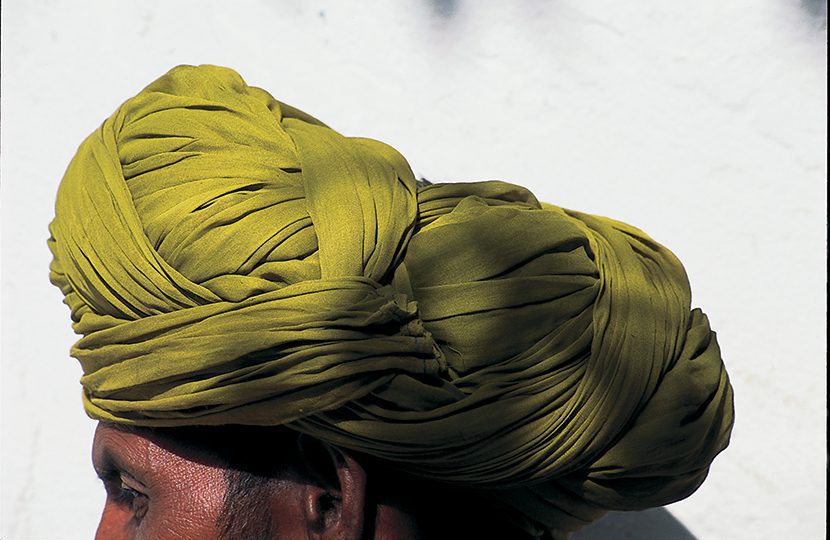
Local head dress
[/vc_column_text][/vc_column][/vc_row][vc_row][vc_column][vc_column_text]And if you haven’t had your fill of shopping by the time you reach Amanbagh, the boutique here has a tight, expert edit from some of Jaipur’s finest including The Gem Palace and Kashmir Loom. This being Aman they promise to fetch more from Jaipur if you wish.
Subscribe to the latest edition now by clicking here.
[/vc_column_text][/vc_column][/vc_row]

